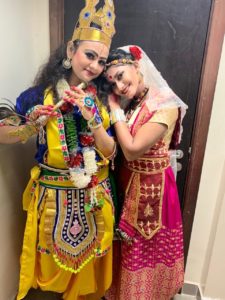Bhaona is a traditional form of drama in Assam, created in the sixteenth century by Srimanta Sankerdeva, and utilized as an audio-visual medium for spreading a social and religious reformative message. Originally, only the staging of the Ankiya Nats written by Sankerdeva and Madhavdeva were called Bhaona– more precisely Ankiya Bhaona.

After the death of Sankerdeva, his disciples from Madhavdeva to Gopal Ata or Daityari Thakur did not intend to keep Bhaona in its strict original ethos. For the demand of time and realistic acceptance among common masses – the art-form was refurbished with a new linguistic flavour and story or content. Some formalities of Bhaona have been shown nominally like Nandi (Benedictory verses) or Mukti Managala (the Sutradhar or narrator prays for forgiveness of God for any fault at the end) as the role of Bhaona.
Moreover, changes occurred in language, instead of Brajawali – the prevalent Assamese language of that period, adapted to popularise and eschew this elite language.
In the years after 17th century, many satras had begun to flourish and challenge, few existing orthodox satras (monasteries). These satradhikars (head of a monastery) wrote many Bhaona scripts. These devotees of Sankerdeva named the plays only written by Sankerdeva or Madhavdeva as Ankiya Nat.
Among the new generation, the cultural aspects of Bhaona have been emphasized and easy entertainment is more meticulously displayed. This is how it is surviving even today, more and less, among all classes and castes of Assam.

This art-form evolved into many forms, based on the overall theme or structure of Sankerdeva such as –Phaujiya Bhaona (started in Cooch Bihar ), Mukha Bhaona (performed wearing mask, mainly in Majuli), Matribhashar Bhaona (in Assamese mother tongue, popular in Upper Assam.), Baresohoria and Hazari Bhaona (simultaneous performance of many Bhaonas, under a single pandal in the middle of North and South bank of Assam), Dhura Bhaona (originated from Dhup Kirtan of Bengal and flourished in Barpeta and Kamalabari monastery – as such Dhuliya Bhaona, Sabah Bhaona, Juri and Cukraganar Bhaona (the Sutradhara character, not available).
Many other little-known terms of this dance-drama are available in the nooks and corners of Assam.
Nowadays, easy cultural exchange across the globe, coupled with the fast development of digital media shows that taste and outlook of people are changing. Bhaona, except for the pivotal theme, can’t be performed as a medieval drama, overlooking modern trends only in the name of showcasing or preserving our heritage.
The shield to safeguard the rich cultural heritage has to evolve with changing time. The fruit of these thoughts is a newly added popular dimension of this art-form, i.e., English Bhaona under the directorship of Arup Saikia, Gitimallika and Girimallika as joint coordinators. Besides modern Indian languages, it has been staged in English language in India, as well as, abroad from 2018 onwards.

The classical or traditional undertone of Bhaona has resonated in songs, dialogues, dance and footsteps in a foreign language.
Bhaona is a product of a composite culture and unseen threads that contribute to unite the people of Assam. It influences Assam very deeply on language, economy and society. New titles related to this art form – gayan, bayan, pathak – and professions of makeup artist and costume maker are created. The mixture of eastern Indian languages- Brajawali has further decorated Assamese modern language with many new wo
Bhaona also displays the broader culture of north eastern India. The headgear or pag is different from one place to another because of local influence. Ghuri or lehenga of the narrator may be taken from Ojapali, jackets may be from Tiwa or Mising, and Tangali is found among Bhuyan clan in medieval Assam.
For popular cultural survival, Bhaona has to be presented as a competitor to prevalent modern drama festivals, with the use of ongoing dramatic infrastructure like decorated proscenium or thrust stage, besides the traditional Namghar (Assamese prayer house) or traverse stage. Moreover, the mode of expression, dialogue, lighting, orchestra, language, and costume should have a glimpse of its unique beauty, surmounting fundamental barriers.
Now it is the moral responsibility of the people of Assam to sustain the legacy of Bhaona in greater acceptability with ingenuous empathy in different form as time demands.
(The author is an alumnus of Delhi University. He is a noted cultural activist, actor, scriptwriter and poet – authored two poetry books, namely Silpi Satta and Sabda. As director, actor and translator he has performed Bhaona in English language for the first time from Assam in India and abroad.)



